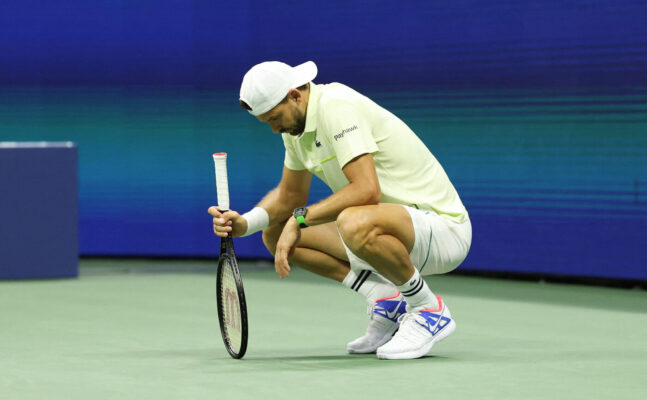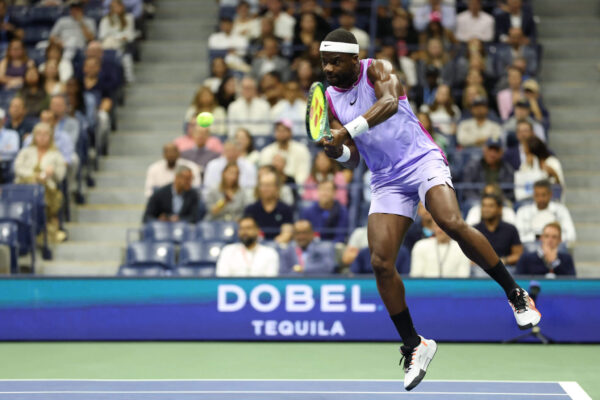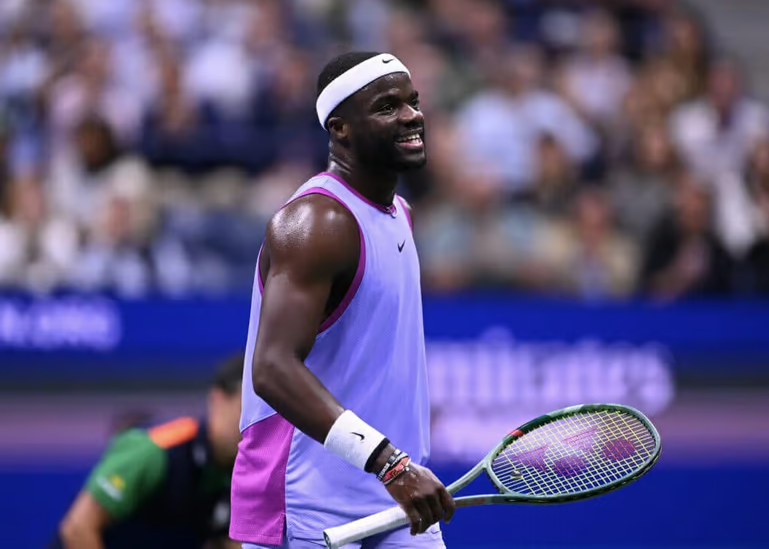Sport
Frances Tiafoe into all-American U.S. Open semifinal against Taylor Fritz
There are some nights when Frances Tiafoe turns Arthur Ashe Stadium into a rocking house party.
His house. His music thumping from the loudspeakers. Nearly 24,000 friends, cousins, kings, queens, stars of the silver screen and hardwood, and of course an all-time tennis great or half a dozen. All of them bounce to his beat, shaking every level of the big tennis court by Flushing Bay.
Tuesday night on Ashe was something else. Not better or worse, especially with Tiafoe rolling into the first all-American U.S. Open semifinal since 2005, when Andre Agassi defeated Robby Ginepri. The same party crowd filled nearly every seat high and low, from courtside to way up near the roof. Kevin Hart, Jason Sudeikis, Roger Federer, Sabrina Ionescu, and a bunch of other A-listers stopped by. It was the quiet hang to the bumping night that turns into morning, smooth jazz and R&B humming through the speakers; glasses clinking with expensive bubbly stuff inside.
But the end of the night, and the 6-3, 6-7(5), 6-3, 4-1 win that finished with an asterisk hanging over a hobbled Grigor Dimitrov? It was not the vibe. It was not the walk-off Tiafoe, or his 24,000 friends, had in mind.
The stadium was already murmuring when Dimitrov served a double fault to end the third set. That wasn’t out of the ordinary, in the wake of the three double faults — two for Dimitrov, one for Tiafoe — that ended the second set in the Bulgarian’s favor.
As he sat down, Dimitrov grabbed at his leg, and gestured to his team, chopping his hand through the night air as if to say, “this is it.” He looked up, and smiled ruefully, scarcely able to believe that this was happening to him, here and now.
He limped off court. He limped back on. Tiafoe served out his first game of the fourth set to love. Dimitrov delivered a first serve at 84mph, as he gainfully tried to continue what had already been two hours and forty-five minutes of strange, attritional tennis.

It got stranger.
Tiafoe did what players often do when an opponent is struggling physically. He hit balls straight to Dimitrov, unable to turn off the pattern-play switch in his brain and move him around the court. Then he figured it out. He dragged Dimitrov into the backhand corner, and shaped one of those whipped, arcing cross-court forehand he hits so well short and wide. Dimitrov didn’t even move.
Tiafoe went up 2-0. Dimitrov stayed on the court.
At 15-0 Tiafoe, Dimitrov clapped his racket at his box, as if asking for some appreciation for staying out there, a beaten man limping. Tiafoe served a double fault at 40-0. He won the game anyway. The air was gone from the stadium. This wasn’t how this was supposed to be.
At 4-1, they hugged at the net, and Tiafoe was into the place he did want to be. The same place he was two years ago, ready to face Carlos Alcaraz and start another house party.
The whole night didn’t go this way. There were a couple of moments of rising energy too, like that celebratory sprint across the baseline, racket raised high after another Dimitrov forehand into the net delivered the first set to Tiafoe. Or when Dimitrov crawled his way to even from a service break down in the second set, with some nifty stab volleys and wrist-flick strokes that have always earned him all those style points.
A few games later, Dimitrov’s legs gave out, the effects of a torturous five-set, fourth-round win on sweaty Sunday coming home to roost. So when it was over, for the guy who throws the parties like no one else these days, this was a chill night. No broken furniture. Everybody gets home safe, and saves themselves for what’s coming on the weekend.

“I’m going to have to be more aggressive,” Tiafoe said on court. “Ultimately man, I’m going to have to dig, dig, dig.
“Semifinal of the U.S. Open, no excuses.”
For American men’s tennis, these are the biggest few days in years. Here’s what you need to know about them, and why.
The All-American semifinal
Tiafoe’s win over Dimitrov sets up a semifinal showdown with his buddy from his early teens, Taylor Fritz, who beat Alexander Zverev of Germany in four sets on Tuesday afternoon.
Fritz and “Big Foe,” as everyone calls Tiafoe, started hitting balls at national camps a dozen years ago. Tiafoe, and their other friend, Tommy Paul, were far better than Fritz back then. Fritz has flipped the script the past three years, mostly holding down the title of American No. 1, though Tiafoe is the bigger star.
The drought in American men’s tennis
Time was Americans ruled men’s tennis. But the world got bigger after the Iron Curtain fell. America’s reliance on its wealth and population to automatically produce the greatest players in the world proved to be its Achilles heel.
The USTA was late to figure this out. By the late 2000s, Andy Roddick was nearing the end of his career. The last American world No. 1, and the last American man to win the U.S. Open (in 2003) didn’t have any major talent behind him.
Tiafoe and Fritz were among the first players the federation focused on as it embarked on a decade-long plan to create players who could compete with the best. It ended up taking longer than that, with Fritz and his compatriots spending the past seven years getting beaten by Roger Federer, Rafael Nadal, and Novak Djokovic, as well as a host of better, more consistent players from Europe. Then Carlos Alcaraz and Jannik Sinner arrived, and they started beating them too.
Come Friday, they will have to go out and beat each other.

The story of Tiafoe’s rise, and stall
Tiafoe has been lost for the past year, ever since his quarterfinal loss to Ben Shelton here 364 days ago. He thought he was destined for the semifinals and beyond. Shelton stole his lunch, grabbed the spotlight and sent Tiafoe spiralling.
Ever since, he’s been losing as much as he wins, and struggling to find motivation. Then, in July, he played his way into a third-round showdown with Carlos Alcaraz on Centre Court at Wimbledon.
He’d never played in the sport’s cathedral before, and he came within a handful of points of knocking out the eventual champion. The crowd roared for him as they hadn’t in a long time. It reminded him of why he plays this game and inspired him to push for a big run at the U.S. Open.
“When I’m playing well it helps the sport, for sure,” Tiafoe said.
When he saw the draw, he couldn’t look past “Ben,” his friend, Shelton. Then he beat him. Then Djokovic went out.
“The draw shakes up,” he said. “And you’re like, why not?”
The matchup
Fritz has a huge advantage. He is 6-1 in their head to head. Tiafoe hasn’t beaten him since 2016, way before Fritz was the player he is today.
They have only played once in a Grand Slam, at the Australian Open in 2022, when Tiafoe was fighting his way out of another slump and into the climb that would culminate in that five-set house party against Carlos Alcaraz.
Tiafoe has the edge in speed and movement and creativity. He has more shots in his racket than Fritz does. But Fritz has the two best shots — his serve and his forehand.
“When I first met him he was an odd cat,” Tiafoe said of Fritz. “Once we all turned pro we pushed each other to be great. Nobody wants to leave each other behind.”
Going all the way?
Two American men in the semis means one will make the final. Fritz or Tiafoe will likely have to beat Jannik Sinner, the world No. 1, or Daniil Medvedev, a six-time Grand Slam finalist and the 2021 U.S. Open champion. There hasn’t been an American man in a major final since 2009, when Roddick lost 16-14 in the fifth set to Federer, shadows slanting across the Wimbledon grass.
Medvedev and Sinner play each other Wednesday in their quarterfinal. The other quarterfinal pits Alex de Minaur of Australia against Britain’s Jack Draper.

